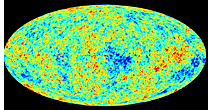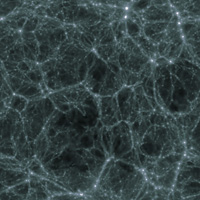
|
||
 |
||
|
Cosmology is the science of the universe as a whole. We live in a scientific age where new knowledge is generated by observation, analysis, and careful deduction. Cosmology is a very active branch of science, which draws upon the principles of mathematics and physics as applied to astronomical and astrophysical observations.
The scientific age began four centuries ago, when scientists such as Galileo Galilei realized that the path to knowledge must be based upon observations of Nature and demonstrated facts (rather than upon dogma or philosophical construct). Prior to the development of the scientific method, philosophers considered ideas and observations, maintaining those that supported their theory and rejecting those that were contrary. The astronomers of ancient Greece put the Earth firmly at the center of the universe because it maintained their principles of physics. It also sustained the obvious deduction that stars could not be so big and far away.
Ibn al-Haytham, or Alhacen, (965–1039 CE) was a Muslim astronomer, engineer, mathematician, and scientist. He also supported the heliocentric model of the solar system, established the use of scientific experiments, and invented the first pinhole camera (in addition to making other contributions to the principles of optics). Galileo is is considered the architect of modern science in Europe because he developed the concepts and principles of careful observations and experimentation of natural phenomena. He developed the Scientific Method. He built a telescope powerful enough to study the moon and planets, and his observations demonstrated that the Copernican model is correct. He then publicized his results, challenging centuries of religious dogma. Under penalty of heresy (death), he was forced to abjure. Nevertheless, the Scientific Method developed by Galileo continued to be the guiding principle for scientists of all disciplines. The rigor of objective analysis combined with the power of mathematics created a new paradigm best characterized by two words: Prove it. Cosmologists develop and use extremely sophisticated scientific instruments and high-power telescopes to observe the most distant objects known. They use powerful computers and algorithms to process and analyze their observations. They work on very complicated mathematical theories to make predictions to test their theories. They study the nature of matter on a scale that is incredibly small as they strive to understand the origins of the universe. Cosmology in the scientific age is a highly specialized branch of science, which has the primary aim of answering fundamental questions about the universe. Cosmologists are perhaps more aware of the need to make their work accessible and coherent to non-scientists as well as to scientists in other disciplines. The big questions of cosmology are of great interest to people from all walks of life. The scientific method has provided the foundation for empirical knowledge, producing surprising answers (and always generating more questions) in the field of cosmology.
Design of the Universe video and Interview with 2006 Nobel Laureates in Physics: George Smoot and John Mather
NASA animation of universe evolution
Is the Universe curved? (graphic) Is it open, flat, or closed? (explanation) News Story about Flatness of Universe
Is the Universe finite or infinite? If it is finite, how big is it? NASA's LISA (LASER Interferometer Space Antenna) will probe this question and many more. What is the future of the Universe?
|


 About the Cosmic Microwave Background
About the Cosmic Microwave Background
 Tour the early universe -
Tour the early universe - 
